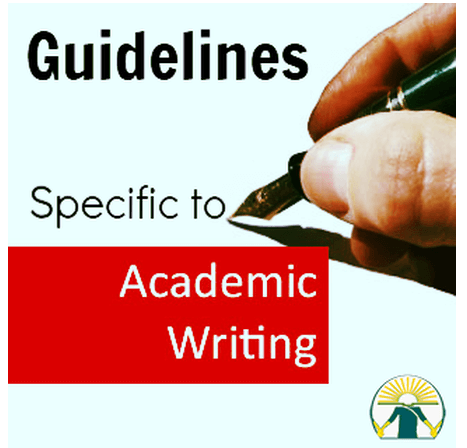Guidelines Specific to Academic Writing

Formatting and grammar rules
When in doubt about grammar or page format, researchers in psychology and computer science generally follow the APA style guide; biological fields use similar standards. Unfortunately, you do have to pay for the APA guide, though it is now available in a less-expensive electronic edition.
Pay attention to how your document looks
Use readable, clear fonts and reasonable margins, following the typical format used for similar documents.
If your word processor cannot make the spacing regular between words (e.g. most versions of Microsoft Word), turn off right justification. Poor spacing makes the page look jumbled and seem incoherent, even if the writing is not.
Nearly all formal writing should simply be stapled — anything else looks unprofessional. For instance, using a fancy cover and binding for a short paper or report is distracting and makes it difficult to photocopy the paper; such binding is necessary only for long papers that a staple would have trouble keeping together. At the opposite extreme, it should be obvious that folding one corner is not an acceptable substitute for a staple.
Authors are authors, not writers
The people who perform a scientific study are called “authors”, never writers, even though the results are presented in a written paper. Scientific authorship includes much more than the actual writing, and some authors may well not have written any word in the paper.
Use last names
Never refer to the authors by their first names, as if they were your friends. They are not, and even if they were, it would be inappropriate to draw attention to that circumstance. Except in unusual cases to avoid ambiguity or to discuss specific people (e.g. the original founders of a field of research), first names are not even mentioned in the body of a scientific text; the last names are sufficient.
Author names are keys — spell them properly
In academic writing, an author’s last name is like the key in a database lookup — if the name is misspelled (e.g. “Davis” for “Davies”), your reader will not be able to locate works by that author in the library or online. Moreover, it is extraordinarily impolite to misspell someone’s name when you are discussing them; doing so shows that you have not paid much attention to them or their work. So you should make a special effort to spell author names correctly, double and triple checking them against the original source, and ensuring that you spell them the same way each time.
Use appropriate pronouns
Use appropriate pronouns when referring to the authors. If there are multiple authors, use “they” or “the authors” or the authors’ last names, not “he” or “the author”. If there is only one author and you can determine the gender with great confidence, you may use “he” or “she”; otherwise use “the author” or the author’s last name.
Referring to other texts
Use double quotes around the title of an article when you refer to it in the text. Italics are reserved for books or other works of similar length. Avoid underlining altogether — underlining is just a way of indicating that handwritten or typewritten text should be typeset in italics, and is thus inappropriate when italics are available (as they are on any modern word processor).
Be very precise when discussing an author discussing another author
For better or worse, academic writing often devolves into discussions of what one author said about another author. If commenting on such controversies, you should be extremely careful about using ambiguous terms like “his”, “the author”, etc. Very often your reader will have no idea which of the various authors you are referring to, even though it may be clear to you. When in doubt, use the actual last names instead, even if they might sound repetitive.
Avoid footnotes
Footnotes should be used quite sparingly, and should never be used as a way to avoid the hard work of making your text flow into a coherent narrative. Only when something genuinely cannot be made to fit into the main flow of the text, yet is somehow still so important that it must be mentioned, does it go into a footnote.
Avoid direct quotes
In scientific (as opposed to literary or historical) writing, direct quotes should be used only when the precise wording of the original sentences is important, e.g. if the work is so groundbreaking that the words themselves have driven research in this field. In nearly every other case, paraphrasing is more appropriate, because it lets you formulate the idea in the terms suitable for your particular paper, focusing on the underlying issue rather than the way one author expressed it.
Be careful with arguments about grammar
If you are going to criticize the grammar or spelling of an author in writing, you should be extraordinarily careful to verify that you are correct. Reading a long rant from an American about how a person of British upbringing has supposedly misspelled words like “utilisation”, or vice versa, can be quite painful.
There is no need to mention explicitly reading the paper
A lot of students use phrases like “while reading this paper, I …” and “In this paper the authors …”. Try to avoid this redundancy. If you use the word “author” you need not also use “paper”, and vice versa. Similarly, it is clear that whatever you discovered about the paper, you discovered while reading the paper; we do not need to be reminded of this. Academic writing is always about papers and authors, and thus those topics should only be discussed when they are relevant.
Reference:
Dr. James A. Bednar. Tips for Academic Writing and Other Formal Writing
